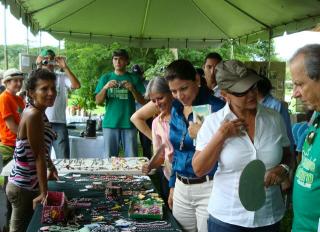 Earth University is the most interesting university in Costa Rica. Allow me to tell you all about this tour that I took recently.
Earth University is the most interesting university in Costa Rica. Allow me to tell you all about this tour that I took recently.
Located just outside Guacimo (Limon) in Costa Rica is a unique university campus. The campus houses EARTH University: Escuela de Agricultura de la Region Tropical Humeda (EARTH); or School of Agriculture of the Humid Tropical Region.
EARTH University is an international, non-profit, private university dedicated to sustainable agriculture and resource management, offering a four-year degree in Agricultural Sciences and Natural Resource Management. It has very high ideals, very high hopes, and a very high success rate. The EARTH University is supported by the EARTH Foundation.
The idea was conceived in the early 1980’s by a group of forward-thinking Costa Ricans who saw a need for an environmental conscience in agrarian societies. Within that need was another sub-part: it would be accomplished with a social conscience at a grassroots level, not a governmental level.
Costa Rica passed a law in 1986 that granted EARTH University its international status, opening the door for support from the W.K. Kellogg Foundation and the U.S. Agency for International Development (USAID). The Costa Rican government, the Kellogg Foundation, and USAID together supported the establishment of the campus in Guacimo in the province of Limon. They constructed the first building in 1989 on the 8154-acre campus. Celebrating 20 years in the spring of 2010, EARTH continues to implement its uniquely innovative and successful educational model. 
Our tour of the campus began with an overview of the philosophy and academic model of EARTH. There is much emphasis on the ethical and social values to prepare these students for the challenges they will face as leaders of change in their own countries. These values are integrated with the scientific and technical knowledge and the entrepreneurial skills that will be necessary to implement the changes in business practices to earth-friendly, sustainable agriculture.
The principles taught students to range from biodiversity conservation and sustainable development in addition to social consciousness, respect, tolerance, and human development.
 As we learned about the academic model we learned about the admission process. The university recruits students from many different countries.
As we learned about the academic model we learned about the admission process. The university recruits students from many different countries.
Every year hundreds of men and women compete for 100-112 positions. These potential students also undergo a rigorous selection process and are selected based on their desire to promote change, their environmental and social awareness, and their commitment and general vocation.
The scholarship program takes the financial aspect out of the selection process. So the most committed candidates are admitted and ultimately affect the environmental change. If any of these new students lack certain academic skills, the Academic Preparation Program strengthens areas such as math, science and study techniques over 16 weeks prior to the start of the academic year.
Upon completion of the four-year program, the majority of the graduates return to their home countries with the knowledge, skills, and ability to implement the changes necessary to help their countries make positive environmental and social change and better their country’s position in today’s global society. 
To date, the university selected attending students from 29 countries in the Americas, the Caribbean, Africa, Europe, and Indonesia. In 16 graduating classes, EARTH has graduated almost 1400 professionals from 25 countries. These graduates work in non-government organizations, government, and the private sector or own their own businesses.
Our visit culminated with a walk into the campus forest. The forest was amazing, particularly the wild almond trees (a favorite of the Great Green Macaws on the Caribbean slope). Feeling like we were worlds away from hustle and bustle because this was a beautiful and relaxing hike looking for frogs and spiders.
At EARTH, they practice what they teach. Therefore, the program gears every activity on campus towards recycling, sustainability, independence, cost-effectiveness, and non-pollution. The integrated animal farm proves a family on a Finca (farm) can start with as few as 4 pigs, 8 chickens or 2 cows and end up with fuel gas for cooking via a bio-digester. The peri-urban program grows food in limited spaces.
- EARTH holds “Day without Cars” 2-3 times per year to reduce their carbon footprint. Their carbon neutral program fixes ten times as much carbon through agriculture and forestry than the campus emits.
- There are many, many good causes in the world, all worthy of donations, but for me, making our planet healthy is a top priority. If we have no healthy place to live, in the end, all the other causes really don’t matter. In addition, EARTH has much fun and satisfying ways to donate.
- Plant a tree: To celebrate the 20th anniversary, on 5th of June 2010 (World Environment Day) EARTH coordinated a worldwide tree planting event in 26 countries. The goal this year was 200,000 trees. They planted more than 1,195,000 trees.
- Attend a concert: A wonderful concert in August in San Jose at the Teatro Nacional was another fun fundraiser.
- Enjoy food: Each year the students invite the public onto campus to experience an organized fundraiser featuring traditional dishes from their home countries which the students prepare themselves. So several thousand people know that this feria is a delicious reason to visit the campus.
Buy and enjoy EARTH-brand bananas. Here in Costa Rica, they are export quality. If you live in Costa Rica you are also able to buy EARTH-brand yogurt at AutoMercado. Encourage family and friends in the United States to buy pineapples and bananas from Whole Foods Markets.
The university offers bird tours- half or full day on the campus in the primary and secondary forest. During one afternoon tour we took into the fields, we observed a Laughing Falcon, tityras and several types of managers. We saw more than 35 different species.

It also offers half day or full workshops on a variety of environmental topics such as peri-urban agriculture (food production in limited spaces (houses, offices, etc.) and composting (a microbial solution to aid composting will be available on campus early in 2011).
For further information on tours and workshops, you may contact:
Carlos A. Araya Q.
Director of Development, A.I.
ERTH University
Tel. (506) 2713.0498
Email: caaraya@earth.ac.cr
In conclusion, Earth University and associated programs have a pretty interesting website. We invite you to take this great tour in Guacimo and see for yourself.
The Author
Cyndi Mayer, now retired and living in Santa Ana is a nature and bird lover. Cyndi took this interesting tour of Earth University and decided to write an article for the Easy Times about it.
Feel free to leave your comments on this blog. If you like this article, please feel free to share it on your social media.
If you like this blog, connect with me on Google+ or subscribe to our newsletter by clicking the banner below.
While we’re at it, I DO want to remind our readers that we appreciate any referrals you can send us. Finally, please remember the American-European real estate Group’s agents when you refer a real estate agent. Because we DO appreciate your business.


















